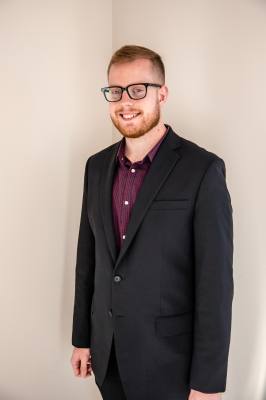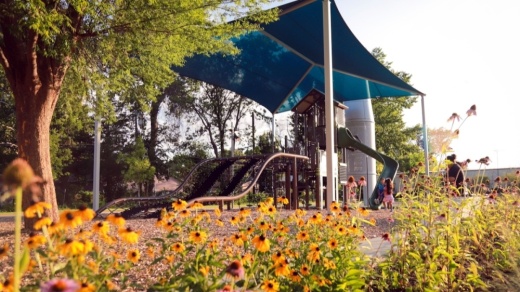The 19-year resident of the city said he considers the investment that McKinney leaders pour into the park system uncommon. Over the past 18 months, Parks and Recreation Director Michael Kowski said his department spent more than $20 million in renovations to east side facilities, including Cottonwood Park, Old Settler’s Recreation Center and the McKinney Senior Recreation Center.
Szecsy also serves as the Erwin Park trail steward for the Dallas Off-Road Bicycle Association, which he said is entirely responsible for maintaining the east McKinney trail. Incorporating direct community involvement into the parks system, he said, has helped make it a main attraction in McKinney.
“Every time there is a plan for a park and its amenities, the city listens and responds to the residents about what they want in their community parks,” Szecsy said. “While not to sound cliché, this is truly something that makes McKinney unique by nature.”
Every eastern park
Kowski said one of his goals within the next three years is to renovate, at least to some extent, every park in McKinney east of Highway 75.
East McKinney is where the city’s historic downtown district resides and where much of the city’s future development will be built, Kowski said. For those reasons, officials have made a concentrated effort over the past year-and-a-half to refresh the eastern half of McKinney.
“The city has made a very specific goal to make sure that we are allocating resources, energy and time toward the east side,” Kowski said. “That's where our new city hall is going. That is where we have a bunch of our special events. ... It just is time to really refresh all those assets that we have there.”
Kowski said the biggest project the parks department completed over the summer was a $6 million expansion to Old Settler’s Recreation Center.
He said his department decided to go “all-in” while the facility was closed in 2020 due to the pandemic, adding over 8,000 square feet, new fitness space and a commercial-grade kitchen. All bathrooms and multipurpose rooms saw renovations, he said.
The parks director described the facility as a hub for all residents surrounding East Louisiana Street.
“It’s really the center of that whole neighborhood,” Kowski said of Old Settler’s Recreation Center. “We've kind of reintroduced it to the whole community.”
Another key project will focus on a facility popular to both residents and outsiders alike: Erwin Park. Kowski said the city will spend $2 million to upgrade bathrooms, expand parking lots and add new signage.
According to recent surveys conducted by the city of McKinney, only about half of weekenders at Erwin Park are McKinney residents, and that any given weekend can see upward of about 1,000 trail users.
“Erwin Park trail attracts over 50% of its users from the surrounding community,” Szecsy said. “Translation: it is an actual city attraction.”
Szecsy said that part of the park’s success comes from the long-term partnership the city has with DORBA volunteers. He added that the partnership has allowed for weekly races this past summer as well as trail running and mountain bike races.
“The 9.5-mile off-road trail in Erwin Park is one of the crown jewels of off-road mountain bike trails,” Szecsy said.
Natural growth
Vision for the McKinney parks system is widely shared among city entities, according to McKinney Community Development Corp. President Cindy Schneible.
“It's two things,” Schneible said. “It's making sure that what we have is kept up, kept nice and renovated when it's needed. And then also looking to the future and making sure that we're planning for and ready to execute on projects to support the new population growth in the city.” The McKinney CDC was created in 1996 after voters approved a ballot issue for a half-cent sales tax to be invested into quality-of-life improvements, such as parks and recreation centers. Schneible said that measure piggybacked off of a fruitful half-cent sales tax that voters approved in 1993 for economic development.
“Voters saw this as an opportunity to collect that half cent and invest it in amenities that make that community even nicer,” Schneible said.
Schneible came aboard the McKinney CDC in 2010, when the yearly sales tax revenue was $8 million. She said revenue next year is projected to be around $17 million, and that nearly half of it is dedicated to city parks.
What the CDC often hears from existing businesses, according to Schneible, is the importance of access to walking and biking trails, parks and athletic fields.
“It's an additional selling point, if you will, for McKinney to have a nice park system and any other amenities that can be offered,” Schneible said.
Mayor George Fuller underscored the importance of widespread and quality facilities. This year, he said the city will begin work on converting soccer fields at the McKinney Soccer Complex at Craig Ranch to synthetic turf to ensure year-round play.
“This will help re-energize surrounding neighborhoods and re-establish the local park as a great place to relax, gather and play,” Fuller said.
Over the course of 2020, the parks department reported that city facilities saw a roughly 100% increase in park usage based on waste collection statistics, Kowski said. The mayor expressed a continuing focus on investing into McKinney parks in light of that statistic.
“I believe this is a strong testament that our parks system contributes to the well-being of our community and residents need and appreciate this valuable resource,” Fuller said. “We need to continue our support.”
Key benefits
National nonprofit The Trust for Public Land advocates for the creation and protection of parks to promote health and livability.
Molly Plummer, senior program manager for the nonprofit’s North Texas region, said preserving park land in the midst of heavy home construction and the COVID-19 pandemic is vital.
She said right now is the best time for city officials to conserve parkland for greenspace before parts of Collin County develop without it. Thousands of people, Plummer said, are moving into Collin County due to an increased demand for homes in urban areas. Kowski said that drives competition against the city for securing land for parks.
Plummer added that park funding is at risk across the country due to economic consequences of COVID-19.
“Development and construction has now picked back up in the region and is moving full steam ahead,” Plummer said. “We still need to prioritize protecting and creating parks that serve those new communities and the existing ones in North Texas as development continues.”
Despite competition, Kowski said the city remains focused on the park system despite high demand for land from homebuilders. Fees are imposed on home developers in McKinney whenever they build out new communities, and with that money, the parks director said the city can only invest toward a park in that nearby community.
The city of McKinney is also making proactive efforts to preserve land. On July 29, the city announced a $23 million acquisition of 230 acres of parkland within the Painted Tree residential development on the southwest corner of County Road 1006 and Bloomdale Road.
Walkability to parks within the city is a main focus for both The Trust for Public Land and the city of McKinney.
Kowski said his department is interested in building parks and facilities that are connected through a safe trail network. He pointed to the 25-mile loop of connected trails and parks throughout the city.
“We are constantly assessing where to deliver new parks across the community and aim to create a parks system that is accessible and walkable to as many residents and visitors as possible,” Kowski said.
Communities and individuals see “incredible benefits” from having a park, trail or greenspace within a 10-minute walk of their home, according to Plummer. She said a key reason this is particularly important in Texas is that greenspaces help to combat intensified heat during sweltering summer months, thereby decreasing negative health outcomes.
“Close to home parks are critical to community health and resiliency—we really saw how important these shared outdoor spaces were during the initial COVID lockdown,” Plummer said. “Parks provide a multitude of environmental, economic, community and health benefits to those who live near them.”





